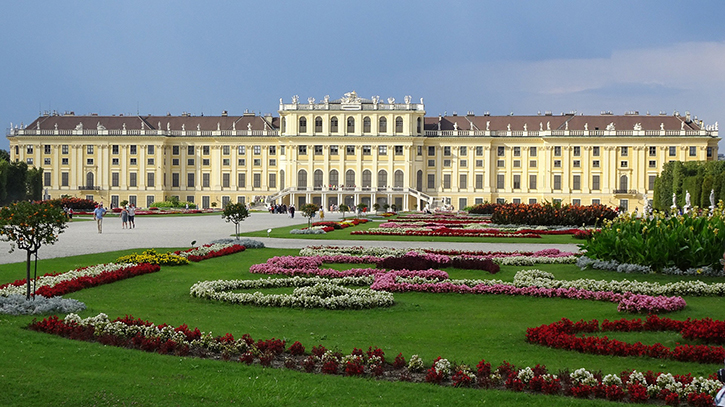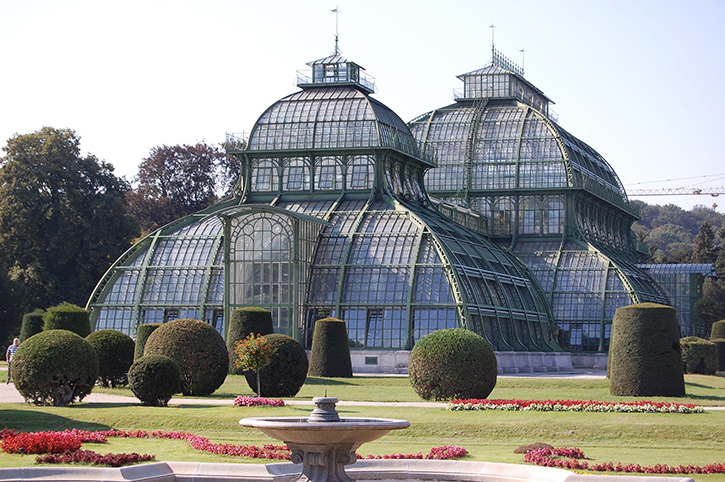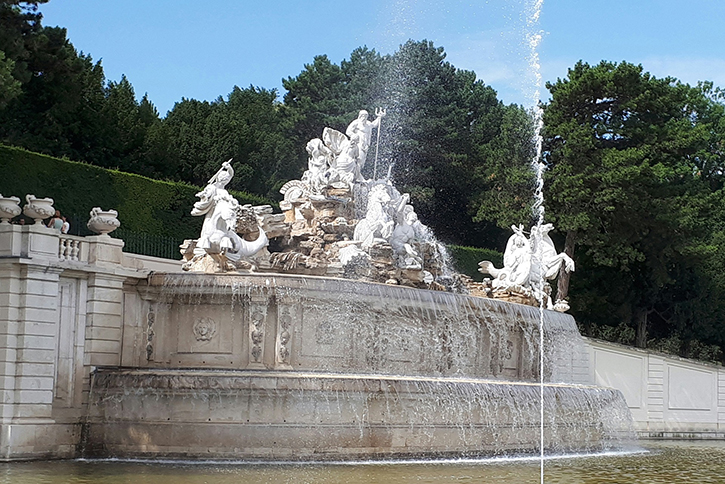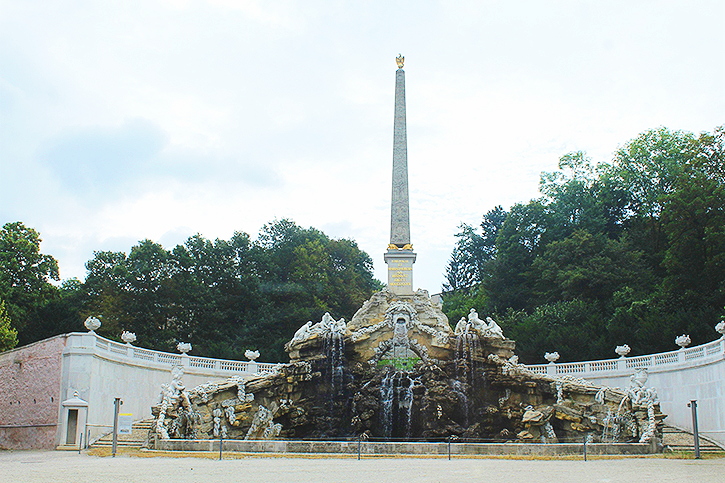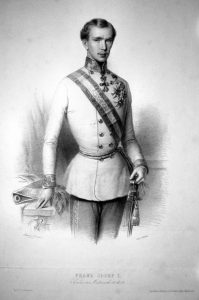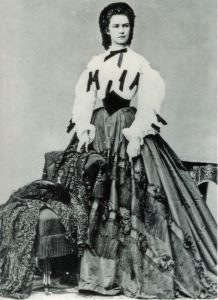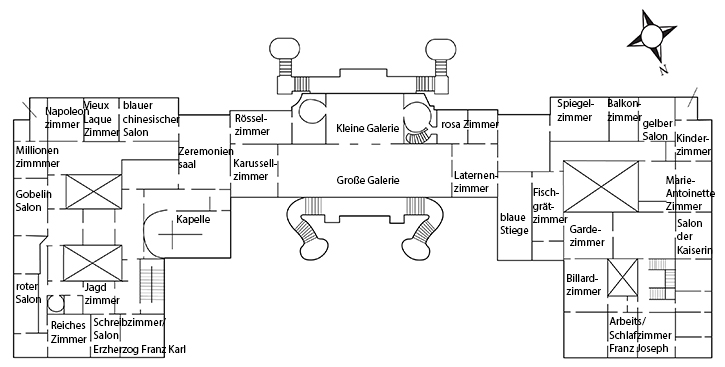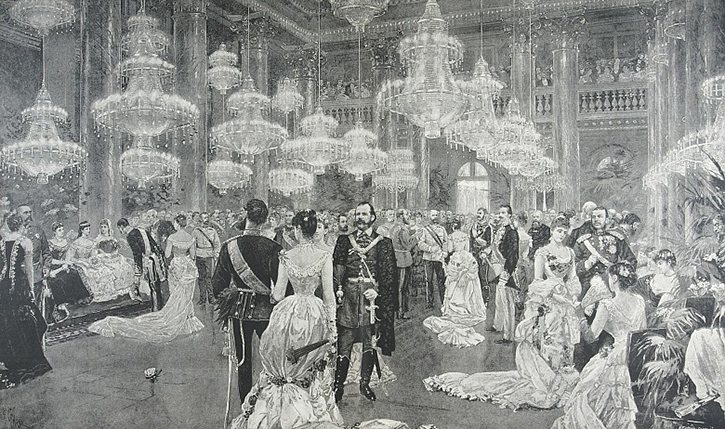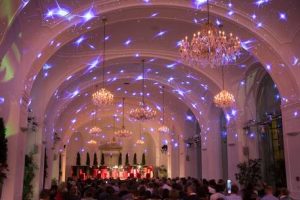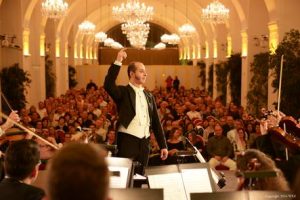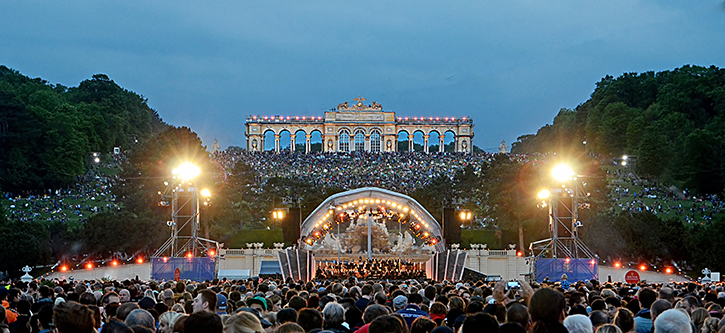Schoenbrunn Palace in Vienna is not only the largest palace in Austria, it is also one of the most visited sights in Vienna, second only to St. Stephen’s Cathedral. Last year, almost 4 million tourists visited the former imperial summer residence…
The Viennese themselves love the area. Whether walking or jogging in the park, swimming in the outdoor pool area, or visiting the zoo with the family at Schoenbrunn. And seeing the city from the Gloriette is something everyone visiting Vienna should do…
Where is Schoenbrunn Palace?
Schoenbrunn Palace is located directly on the Vienna B1 and everyone who drives the A1 entering the city from the west drives past it. Immediately after the Kennedybrücke in Hietzing, where the grand Parkhotel Schoenbrunn is located. Schoenbrunn with its palace, the zoo and the whole park area, as well as the Gloriette is one of Vienna’s 89 cadastral communities and belongs to the municipality Hietzing. Visitors coming from the west can not miss it on the way to the city; unless they stare left …
What size is Schoenbrunn?
The entire area covers about 190 hectares. The most striking places in the area are the castle itself, the Zoo Schoenbrunn, the Gloriette, which overlooks the whole of Vienna, the palm house and the maze.
More attractions
In addition to the mentioned and most well-known places on the area, there are many more. Most Viennese have not even seen everyone.
There is still the little Gloriette, at the entrance to the area on the Hohenbergstraße. In addition to the Palm House, there is also the dovecote, the sundial house and the prince’s play pavilion. In addition to the eponymous fountain (more on that later), you will also find the Obelisk Fountain and the Neptune Fountain. Innumerable gardens are maintained and maintained by many diligent, to a large extent also voluntary, gardeners.
The history of Schoenbrunn Palace
This is a long and eventful story. Almost everyone thinks of Empress Elisabeth (Sisi) in connection with Schoenbrunn Palace. That’s not wrong. It was the summer residence of Empress Elisabeth and Emperor Franz Joseph. But that was not always the case and the story goes back much further.
It all started with a mill, the so-called Khattermill, which stood on this area and which was owned by diocese Klosterneuburg since the year 1312. In 1548 the area was sold to the later mayor of Vienna. He had a mansion built on it, which was called Kattercastle. This was bought 20 years later by Emperor Maximilian II and fenced as a hunting area. With almost 200 hectare total area a pretty large hunting area.
Schoenbrunn and the Habsburgs
In addition to his hunting area, Maximilian also had fish ponds laid out and today’s pheasant garden gets its name from the settlement of exotic birds by the emperor, such as peacocks or turkeys. The whole hill on which today the Gloriette stands was at that time completely wooded. Instead of the mill, a hunting lodge was built in 1570.
Another 20 years later, the hunting lodge was sold by Ferdinand II, the nephew of Maximilian. Again 20 years later, in 1612, happened something because of which Schoenbrunn Palace received its name, though not yet officially.
Where does the name Schoenbrunn Palace come from?
In 1612, Emperor Mathias, son of Maximilian II and thus cousin of Ferdinand II, while hunting in the area that his father had fenced, discovered a fountain. He liked this so much that he exclaimed “What a beautiful fountain” (in German: “Welch schoener Brunnen”) and then he made extensions to the castle. So, Schoenbrunn Palace means literally translated “beautiful fountain palace”. The name Schoenbrunn itself appears officially only 30 years later. At this time, the area is the widow’s residence of the widow of Ferdinand II. She had the castle extended further and, for the first time as a delivery destination, `Schloss Schoenbrunn´ is written on an invoice for a large-scale delivery of trees (for the beginnings of the orangery). Thereafter, the castle served as a widow’s seat for the widow of Ferdinand III. During the Turkish siege of Vienna Schoenbrunn was severely damaged.
Who built Schoenbrunn Palace?
It was not until 1687 that an architect was again commissioned with the planning of a new building. It is interesting that this architect was Johann Bernhard Fischer (later: Fischer of Erlach). This architect is responsible for many important buildings – especially in Vienna. His first design was so splendid that Schoenbrunn would have even surpassed Versailles in pomp and ceremony. However, they agreed on a more modest version.
The same architect was also responsible for the former court stables, now known and popular in Vienna as the Museum´s Quarter, the Court Library, and the Winter Riding School of the Hofburg. In addition, the St. Charles Church Vienna, in which today regularly the Mozart requiem (tickets here) and Vivaldi´s Four Seasons is played (tickets here). The architectural influence of `Fischer von Erlach´ extends far beyond Vienna, the list of his works can be found here.
The castle as imperial summer residence
In 1728, Schoenbrunn Palace and its gardens were sold to the imperial court, more precisely to Charles VI. in turn, his daughter Maria Theresa. She was the one who appointed Schoenbrunn as imperial summer residence and had most of the existing renovations made to this day. At that time she also commissioned an avenue from Schoenbrunn to Laxenburg Castle. She also prompted a major renovation of the castle, such as the one-storey elevation. The architect in charge, Nikolaus von Pacassi, was also one of the architects contributing to the construction of the Hofburg Vienna.
In addition, under Maria Theresia, the castle´s theater in the side wing of the castle was opened, in which later Wolfgang Amadeus Mozart was to perform. Similarly, the garden were extended to the menagerie and the botanical garden. The Viennese also owe the beautiful Gloriette to her. Therefore parts of the castle Neugebäude were removed and brought to Schoenbrunn in order to construct the Gloriette. He also planned the construction of the Roman ruin and the obelisk fountain.
The Peace of Schoenbrunn
Not only the Turks besieged Vienna, in 1805 the French arrived in the city due to the third coalition war or “Napoleon’s second”. In this war France stood with the South of Germany battling against the Allies around Russia, Great Britain, Sweden, Austria and Naples. And Napoleon, with his entourage during the occupation of Vienna, had chosen no lesser place than Schoenbrunn Palace. In 1805 they had they quarters there between November and December. In 1809 – as part of the fifth coalition war – the French occupied Vienna again and moved back to Schoenbrunn. On October 14th 1809, the Peace of Schoenbrunn was signed there. Napoleon and Franz I agreed to a peace treaty between Austria and France. However, Austria had to make some additional concessions, it lost an area of about 100,000 km ² and 3.5 million inhabitants, including its sea access to the coastal area of Croatia. Nevertheless, the area of the then great power of Austria still counted 600,000 km ² and 24 million inhabitants. Unimaginable at today’s surface of 83,879 km² and around 8.8 million inhabitants.
Schoenbrunn Palace and Empress Sisi
Despite the times Napoleon lived there, Schoenbrunn Palace was still in imperial hands. So when Franz Joseph I was born in 1830, it was there as well. Everyone had high hopes for him regarding the succession to the throne, since his uncle, the designated Crown Prince Ferdinand, was mentally and physically too weak for proper regency because of his poor health. Ferdinand also had no children and so the focus was first on Franz Joseph’s father, who would, however, subsequently renounce the throne for the sake of his son.
Franz Joseph I was trained at a young age for role of the future Emperor, in his biography even the image of a rather strict drill is painted. Already at the age of 13 he was appointed colonel of the Dragoon Regiment No. 3, which suggests a very military education. At the age of 16, his days were clocked from six in the morning to nine in the evening. In 1848 he was appointed Emperor at the age of 18 years.
Emperor Franz and his Empress Sisi
As it was customary among the Habsburgs, Franz Joseph was also looking for the suitable bride within the relationship. His mother Sophie deemed the daughters of her sister Ludovika and her husband, the Duke Maximilian of Bavaria, suitable for marriage. The main focus was initially on Helene, the eldest daughter. But at an arranged meeting in 1853, Franz Joseph spontaneously fell in love with her younger sister Elisabeth, who was not even 16 years old at the time. Already on April 24th 1854, the wedding of the two took place. Franz had been Emperor for 6 years, while Sisi – who had enjoyed a very liberal childhood – had barely a year to complete the school of the imperial court. Problems were inevitable. Elisabeth was a very intelligent, sensitive and very liberally educated woman, who had a hard time settling into the conservative lifestyle full of conventions at the court.
Schoenbrunn Palace was primarily a summer residence for her and her family, and in the winter they lived in the Hofburg. It is said that Sisi had a tense relationship with Schoenbrunn. That may have come from the strict control of her mother-in-law there.
The spatial layout of Schoenbrunn Palace
The representative salons were uniformly furnished in the typical white-red-gold color scheme.
With the marriage of Franz and Elisabeth Schoenbrunn was fundamentally renovated, the emperor received his apartment in the west wing, where he could live, work and receive guests. Elisabeth got an apartment in the direction of Hietzinger Kammergarten. A few years later, in 1862 she had a fully furnished ground floor apartment.
So she wallpapered the walls in her favorite color purple and set up a direct exit to the garden, which she could use unnoticed by the staff. Nearby was the indoor riding school (today housing the collection of imperial carriages) where Elisabeth practised her dressage. In remote parts of the Schönbrunner Park, she often rode out, often accompanied by her dogs: “In Schönbrunn, I own the Gloriette and those parts of the park that the public does not like.”
(source: https://www.habsburger.net/en/)
room plan of the beletage at 1st floor – names in original German
The end of the monarchy in Schoenbrunn
The older Franz Joseph became, the more he shifted his life to Schoenbrunn all year round. At the age of 86, he died there in his bedroom on 21 November 1916 during the First World War.
Franz was followed by Charles I in his office. He signed two years later – on 11 November 1918 – in Schoenbrunn the waiver and thus resigned all government business. On 12 November 1918 at 15 clock, the Republic of Austria was proclaimed.
Thus, Schoenbrunn Palace went into state ownership. The accesses were locked and an inventory was made. The resident there, including the servants of the imperial family initially kept their right of residence there.
There were numerous plans for future use of the castle, which the old-established residents were very skeptical of. Among other things, war invalids were initially quartered in the castle. In the summer of 1919 – also not to the delight of the neighbors – the Social Democratic Organization of Children’s Friends founded an orphanage and a nursery school in a part of the outbuildings of the castle but due to organizational problems this held only a few years […]
Of course, the use of parts of the castle as a school, for children and disabled people because of war injuries did not affect the former imperial apartments, which were intended for museum use. Already in 1919 the possibility of visiting the palace is proven. Interestingly, in the 1920s, the entrance fees for foreigners (this included the inhabitants of former crown lands) were twice as high as for nationals and Germans. As early as the end of the 1920s, around 20,000 guests were being led through the rooms every month.
(source: https://www.habsburger.net/en/)
an imperial court ball at Schoenbrunn shortly before the end of the monarchy, 1918
Schoenbrunn Palace today
As mentioned, Schoenbrunn Palace is one of Vienna’s most important sights today. If one adds to the four million visitors of the castle mentioned above the approximately five million visitors of the park and its facilities, one arrives at about nine million people per year. Thus Schoenbrunn records sales of more than 60 million euros per year. Schoenbrunn Kultur- und Betriebs GmbH is responsible for the administration and maintenance of the area. Part of the 1441 rooms that belong to Schoenbrunn Palace and that do not serve as a museum will be leased to private individuals.
Classical Concerts at Schoenbrunn Palace
In addition to the museum rooms, there are a variety of guided tours, such as the Sisi Tour, an Imperial Tour and more. Exact information about the tickets and tours can be found on the homepage of Schoenbrunn Palace.
The palace and its park (the “Ehrenhof”) are also very popular as a concert venue. For example, musical greatnesses such as Lenny Kravitz and David Gilmour (Pink Floyd) gave open air concerts, most recently the concert of the Austrian band Bilderbuch was a great success. Even stars of the Austro-Pop scene give a concert together here in 2019. Under the title “Best of Austria meets Classic” they perform Austrian evergreens with the backing of a large symphony orchestra under the direction of Christian Kolonovits.
An absolute highlight among the classical concerts in Vienna is the Summer Night Concert of the Vienna Philharmonic, which takes place every year in June. Admission is free, places are limited (albeit many), and every year, people arrive hours in advance. People spread over the entire area, up to the Gloriette. But the setting is just unique!
The orangery and other halls are often rented for various events, one of which is the daily classical concert in Schoenbrunn Palace. Up to 400 guests each evening listen there to the famous and some of the less well-known works of Wolfgang A. Mozart and Johann Strauss. Starting at 8.30 pm. The pieces are interpreted by a chamber orchestra under the direction of a conductor.
On April 3, 2019, the concert organizer of the Schönbrunner Klassikkonzerte celebrated his 8000th anniversary concert.
above: pics of the daily classical concerts in the Palace, below: summer night´s concert of the Philharmonics
CC attributions:
pic obelisk fountain: By Dguendel – Own work, CC BY 4.0, https://commons.wikimedia.org/w/index.php?curid=56825162
pic room plan Schoenbrunn: By Gryffindor; vectorized by: GothikaThis W3C-unspecified vector image was created with Adobe Illustrator. – Own work by the original uploader, CC BY-SA 4.0, https://commons.wikimedia.org/w/index.php?curid=60340219
changes made: room titles filled in
Palace concerts Schoenbrunn: Copyright by WKE 2016 https://www.imagevienna.com/de/services/downloads/fotos.html
Sommernachtskonzert: By Alfred Pertl – Own work, CC BY-SA 4.0, https://commons.wikimedia.org/w/index.php?curid=40264211
